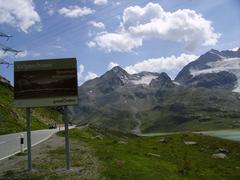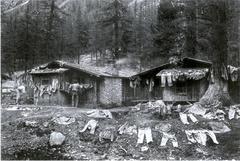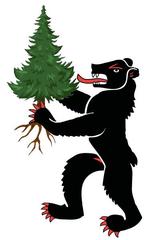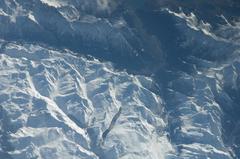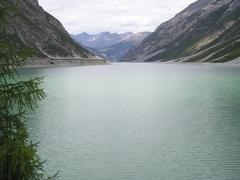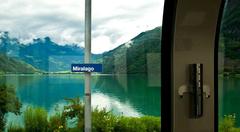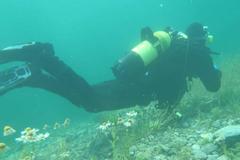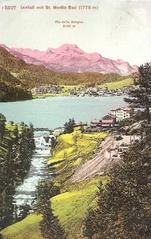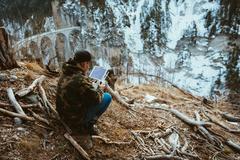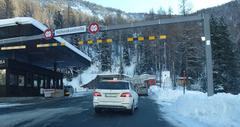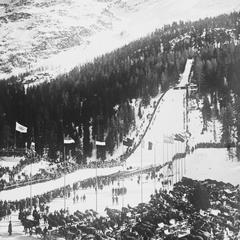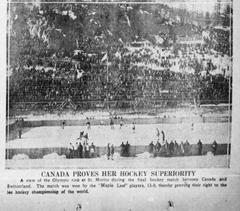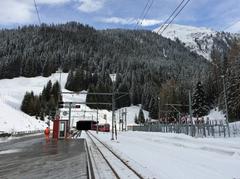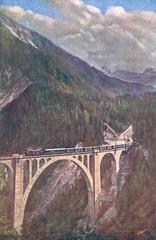
Lago Bianco Visiting Hours, Tickets, and Travel Guide – Canton of the Grisons, Switzerland
Date: 15/06/2025
Introduction to Lago Bianco and Its Significance
Lago Bianco, meaning “White Lake” in Italian, is a pristine alpine reservoir perched at 2,234 meters on the Bernina Pass in Switzerland’s canton of Graubünden (Grisons). Famed for its turquoise waters, dramatic mountain vistas, and unique position on the European watershed, Lago Bianco is both a hydroelectric powerhouse and a gem for nature lovers, hikers, photographers, and cultural enthusiasts. Its location—where waters flow south to the Mediterranean and nearby Lej Nair drains north to the Black Sea—highlights its hydrological and strategic importance. The lake was created in the early 20th century by merging two smaller natural lakes through the construction of the Scala and Arlas dams, and today it plays a vital role in regional renewable energy production.
The region’s rich multicultural heritage—where German, Romansh, and Italian intersect—infuses every visit with tradition, language, and history. Lago Bianco sits at the heart of a network of UNESCO World Heritage Sites, including the Rhaetian Railway and the Swiss Tectonic Arena Sardona. Whether you arrive via the panoramic Bernina Express or by scenic mountain road, Lago Bianco invites you to discover the grandeur of the Swiss Alps and the deep heritage of Graubünden.
For further details on transport, hiking, and tours, refer to official resources:
Official Bernina Express website, Graubünden Tourism – Lago Bianco.
Contents
- Introduction
- Location and Physical Geography
- Visiting Hours and Ticket Information
- How to Get There and Accessibility
- By Train
- By Car
- Trails and Mobility
- Highlights and Photographic Spots
- Special Events and Guided Tours
- Historical Background
- Environmental and Strategic Importance
- Hydroelectric Power Generation
- Climate and Best Time to Visit
- Nearby Attractions and Historical Sites
- Tourism Impact and Sustainability
- Hiking and Outdoor Activities
- Facilities and Amenities
- Cultural and Environmental Insights
- Responsible Tourism
- FAQ
- Practical Tips for Visiting
- Visuals and Interactive Elements
- Conclusion and Call to Action
Location and Physical Geography
Lago Bianco lies on the Bernina Pass, straddling the municipalities of Poschiavo and Pontresina in Graubünden. The reservoir stretches nearly 2.85 km in length and up to 800 meters wide, with a surface area of about 1.5 km² and a maximum depth of 53 meters. Its high-alpine location means the surrounding landscape is rugged, with glaciers, wildflower meadows, and snow-capped peaks shaping the scenery (Wikipedia, Komoot).
Visiting Hours and Ticket Information
Lago Bianco is freely accessible year-round; there are no entrance fees to visit the lake or hike the surrounding trails. For safety and best experience, it is recommended to visit during daylight hours from May to October, when trails are generally snow-free. Any fees pertain to transport (e.g., Bernina Express tickets) or guided tours, not lake access.
- Facilities: Hotel Bernina Hospiz and seasonal kiosks operate mainly from late spring through early autumn, generally 8:00 AM–6:00 PM.
- Bernina Express: Tickets required (book online or at stations).
- Guided Tours: Advance booking recommended for specialized excursions (Official Bernina Express website).
How to Get There and Accessibility
By Train
The Bernina railway, operated by Rhaetian Railway, skirts Lago Bianco’s eastern shore. Ospizio Bernina station (2,253 meters) is the key access point, offering direct trail connections. The Bernina Express is renowned for panoramic windows and UNESCO World Heritage status (Trek Zone).
By Car
The Bernina Pass road (Hauptstrasse 29) runs parallel to the lake at a higher elevation. Parking is available near Hotel Bernina Hospiz (Touring Switzerland). The road is typically open May–October, depending on snow.
Trails and Mobility
Well-marked hiking trails circle Lago Bianco and connect to other passes and valleys. Most trails are moderate, but alpine terrain can present challenges; not all are suitable for wheelchairs. In winter, snowshoeing and cross-country skiing are popular.
Highlights and Photographic Spots
- Turquoise Waters: Best viewed from Ospizio Bernina and along the Bernina Express route.
- Sassal Mason Viewpoint: Offers sweeping vistas of the Bernina Range, including Piz Bernina and Piz Palü (Komoot).
- Railway Crossings: Iconic shots of the Bernina Express with lake and mountains.
Special Events and Guided Tours
While Lago Bianco itself does not host regular events, the Bernina Pass region features seasonal guided hikes, birdwatching tours, and winter sports. Local tourism offices and hotels provide information on available experiences.
Historical Background
Lago Bianco’s formation via early 20th-century dam construction unified two lakes for hydroelectric use (Wikipedia). The Bernina Pass has served as a vital alpine crossing since Roman times, and today, the Rhaetian Railway traverses this historic corridor, recognized as a UNESCO World Heritage Site.
Environmental and Strategic Importance
The lake’s location on the watershed dividing Mediterranean and Black Sea flows highlights its hydrological significance. Lago Bianco supports unique alpine flora and fauna and contributes to regional water management and conservation (Touring Switzerland).
Hydroelectric Power Generation
Lago Bianco is a key reservoir for hydroelectric power in Val Poschiavo, with a capacity of 18.6 million cubic meters. There are plans for a pumped storage project to link Lago Bianco and Lago di Poschiavo for enhanced grid stability (Repower).
Climate and Best Time to Visit
The region features cold, snowy winters and cool, short summers. The best time to visit is June through September, when hiking trails are open and alpine wildflowers bloom. In winter, the lake often freezes, and the area is suitable for snow sports (Travalour).
Nearby Attractions and Historical Sites
- Lej Nair: A neighboring lake with different watershed characteristics.
- Cavaglia Glacier Garden: Offers glacial geology and “giant’s kettles.”
- Poschiavo: A village with Italianate architecture and Mediterranean flair (switzerlanding.com).
- Diavolezza Cable Car: Access to glacier viewpoints and high-altitude hikes.
- Pontresina: Home to the Bernina Pass Museum and additional cultural attractions.
Tourism Impact and Sustainability
Tourism is crucial for Graubünden’s economy, supporting local employment and community well-being. Sustainable practices—including organic agriculture (about 50% of farms) and trail management—ensure environmental preservation (tourismteacher.com, komoot.com).
Hiking and Outdoor Activities
- Lago Bianco Circuit: A 7–8 km moderate hike with continuous views.
- Nearby Peaks: Ascents to Sass Queder, Piz Trovat, and glacier hikes.
- Wildlife Watching: Marmots, ibex, alpine birds, and wildflowers abound.
Facilities and Amenities
- Hotel Bernina Hospiz: Offers lodging, dining, and restrooms.
- Seasonal Kiosks: Limited food and drink options; best to bring snacks.
- Restrooms: Available at the hotel and Ospizio Bernina station.
Cultural and Environmental Insights
- Multilingual Heritage: German, Romansh, and Italian are all spoken (gr.ch).
- Cultural Events: Festivals, markets, and culinary experiences in nearby villages.
- Hydroelectric Infrastructure: Dams and historical displays interpret the lake’s engineering importance.
Responsible Tourism
Follow Leave No Trace guidelines: stay on marked trails, pack out litter, and respect wildlife and livestock. Sustainable tourism ensures the preservation of Lago Bianco’s natural and cultural treasures for future generations.
Frequently Asked Questions (FAQ)
Q: Are there entrance fees to visit Lago Bianco?
A: No, access is free year-round.
Q: When is the best time to visit?
A: Late spring to early autumn (June–September) for hiking; winter for snow sports.
Q: How do I reach Lago Bianco?
A: By Bernina Express (Ospizio Bernina station) or by car via the Bernina Pass road.
Q: Is the area accessible for people with disabilities?
A: The train and hotel offer accessible facilities, but most trails are not wheelchair-friendly.
Q: Are guided tours available?
A: Yes, local tourism offices organize seasonal tours.
Q: Can I swim or fish in the lake?
A: Swimming and fishing are generally not advised due to cold temperatures and fluctuating water levels.
Practical Tips for Visiting
- Transport: Use the Bernina Express for scenic, eco-friendly travel.
- Clothing: Dress in layers for variable alpine weather.
- Timing: Arrive early for quiet trails and best photography.
- Food: Bring snacks/picnic; local options are limited.
- Safety: Protect against sun and weather; carry a map or app.
- Language: English is widely spoken, but German, Italian, and Romansh are prevalent.
- Travel Documents: Bring your passport if crossing into Italy via the Bernina Pass.
Visuals and Interactive Elements
Include high-quality images of Lago Bianco, the Bernina Express, and nearby peaks. Embed an interactive map of trails and train routes. For virtual tours and official maps, see MySwitzerland Virtual Tours.
Conclusion and Call to Action
Lago Bianco unites natural splendor, cultural richness, and engineering marvels in one unforgettable destination. Whether arriving by train, car, or on foot, visitors are rewarded with sweeping alpine views, rich multilingual traditions, and a deep connection to Swiss heritage.
For the latest updates on visiting hours, ticketing, and events, download the Audiala app and follow our channels. Plan your trip to Lago Bianco today and experience the magic of the Swiss Alps!
References and Further Reading
- Bernina Express
- Graubünden Tourism – Lago Bianco
- Touring Switzerland: Lago Bianco at the Bernina Pass
- Komoot Highlights: Lago Bianco
- Swiss National Park and Conservation
- Repower Annual Report: Lago Bianco Project
- Wikipedia: Lago Bianco
- Travalour: Lago Bianco
- Together in Switzerland: Grisons
- MySwitzerland Virtual Tours
- Swiss Travel System
- Tourism Teacher: Tourism in Switzerland
- Switzerlanding: Poschiavo
- gr.ch: Overview of Grisons
- Trek Zone: Lago Bianco

